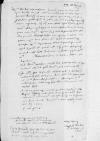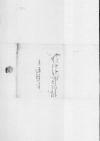Letter #2752
Sigmund von HERBERSTEIN to Ioannes DANTISCUSVienna, 1544-08-28
| received Wormditt (Orneta), 1544-10-21 Manuscript sources:
Auxiliary sources:
Prints:
| ||||||||||
Text & apparatus & commentary Plain text Text & commentary Text & apparatus
Reverendissimo domino, domino
Reverendissime Domine, domine observandissime, servitutem meam in primis Vestrae Reverendissimae Dominationi commendo.
Occurrit nuntius satis commodus ad dominum
Aiunt summum
Datae
Eiusdem Vestrae Reverendissimae Dominationis obsequentissimus
Postscript:
Locustarum ingentes copiae tarde quidem advenerunt, attamen milium et gramina omnia consumunt, oleribus et vitibus pepercerunt.
Naves vicecancellarius caesaris scribit ex
[1 ] See Herberstein’s letter to Duke Albrecht von Hohenzollern of the same date as the present letter Voigt, p.288), cf. cf. EFE 49 No. 481, p. 102, No. 483, p. 106, No. 486, p. 110 ⌊Elementa, XLIX, No. 481, p. 102, No. 483, p. 106, No. 486, p. 110cf. EFE 49 No. 481, p. 102, No. 483, p. 106, No. 486, p. 110 ⌋
[2 ] Mustafa was well educated and sensible, he was quite popular as the expected successor to Suleiman I, as confirmed for example by the opinion of a French envoy, Guillaume Postel from 1537. In 1553, because of the intrigues of Khasseki Khurrem (Roxolana) and grand vizier Rüstem Pasha, he was accused of plotting against his father, who sentenced him to death. Herberstein sent Duke Albrecht von Hohenzollern the news of Mustafa’s plotting as novitates from Venice, in a letter of the same date as the present one (see cf. CLOT 2012 p. 155-158 ⌊Clot, p. 155-158cf. CLOT 2012 p. 155-158 ⌋; cf. VOIGT 1857 p. 288 ⌊Voigt, p. 288cf. VOIGT 1857 p. 288 ⌋, cf. cf. EFE 37 No. 863, p. 100-101 ⌊Elementa, XXXVII, No. 863, p. 100-101cf. EFE 37 No. 863, p. 100-101 ⌋)
[3 ] His reputation in his youth is best reflected in his nickname, the Sot
[5 ] Hadim Suleiman Pasha, beylerbey of Egypt, notoriously cruel and ruthless grand vizier (1541-1544). He became the grand vizier aged almost 90 (see cf. CLOT 2012 p. 194-196 ⌊Clot, p. 194-196cf. CLOT 2012 p. 194-196 ⌋)
[6 ] On June 30, 1544 Barbarossa and a fleet of 180 ships captured Lipari and began a two-week siege of the fortress, which capitulated after heavy bombing. The town was pillaged and about 10,000 residents were abducted (cf. ⌊Elementa, XXXVII, No. 863, p. 101 ⌋; cf. CDC 2 No. 274, p. 261 ⌊CDCV, II, No. 274, p. 261cf. CDC 2 No. 274, p. 261 ⌋; cf. VOIGT 1857 p. 288 ⌊Voigt, p. 288cf. VOIGT 1857 p. 288 ⌋)
[7 ] Planning to hold a general council in Trent to unite Christianity, pope Paul III wanted to be a part of the peace negotiations between Emperor Charles V and the king of France, Francis I. He sent two legates to precede the papal nuntios: Giovanni Girolamo Morone (1509-1580), cardinal from 1542, was sent to the emperor on July 30, 1544, while Marino Grimiani (c. 1489-1546), cardinal from 1527, was sent to France. The missions were undertaken too late. Upon reaching Lyon, the envoys learned that the peace of Crépy had been signed on September 18 (see Lestocquoy 1963, p. XXXIII; cf. JANSSEN 1904 VI, p. 256-260 ⌊Janssen, VI, p. 256-260cf. JANSSEN 1904 VI, p. 256-260 ⌋; cf. cf. VOIGT 1857 p. 288 ⌊Voigt, p. 288cf. VOIGT 1857 p. 288 ⌋)
[8 ] The siege of Saint-Dizier, which had been excellently fortified by Girolamo Marini and defended itself fiercely, lasted from July 8 till the capitulation of the garrison on August 17, and halted the impetus of Charles V’s campaign, the goal of which was Paris (see cf. KOHLER 1999 p. 287 ⌊Kohler I, p. 287cf. KOHLER 1999 p. 287 ⌋; cf. FERNÁNDEZ ÁLVAREZ 2002 p. 656 ⌊Fernández Álvarez 2002, p. 656cf. FERNÁNDEZ ÁLVAREZ 2002 p. 656 ⌋; cf. Knecht 1994 p. 491 ⌊Knecht, p. 491cf. Knecht 1994 p. 491 ⌋; cf. CADENAS Y VINCENT p. 312-313 ⌊Cadenas y Vicent, p. 312-313cf. CADENAS Y VINCENT p. 312-313 ⌋; cf. cf. DU BELLAY 1919 p. 257-259 ⌊du Bellay, IV, p. 257-259cf. DU BELLAY 1919 p. 257-259 ⌋; cf. EFE 37 No. 863, p. 102 ⌊Elementa XXXVII, No. 863, p. 102cf. EFE 37 No. 863, p. 102 ⌋)
[11 ] A reference to the assemblies and meetings called by Ferdinand I in the countries under his rule, to pass taxes for new recruitments in expectation of another Turkish invasion (cf. cf. VOIGT 1857 p. 288 ⌊Voigt, p. 288cf. VOIGT 1857 p. 288 ⌋; cf. HERBERSTEIN 1855 p. 363-364 ⌊Herberstein 1855, p. 363-364cf. HERBERSTEIN 1855 p. 363-364 ⌋)

